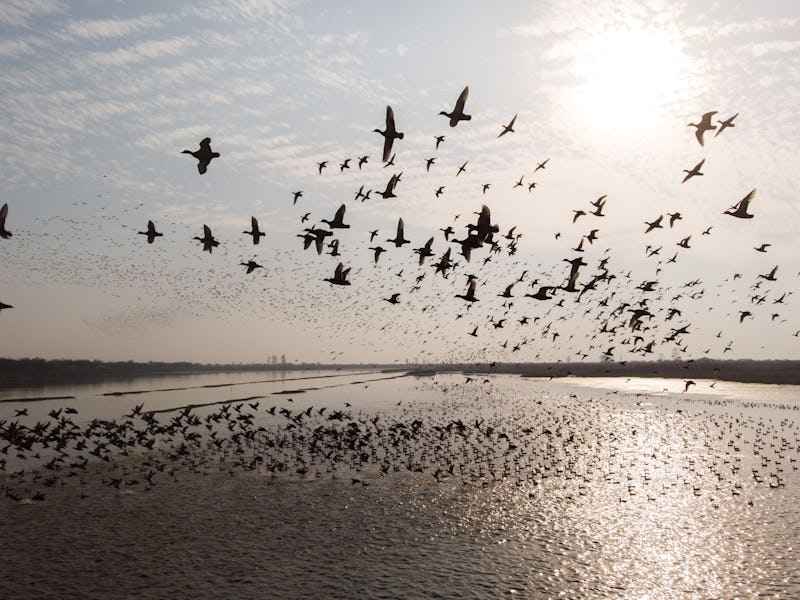Migrating animals have a different way to solve the 'problem of life'
Animals on the move have a faster pace of life — in more ways than one.

Why do billions of animals migrate each year? For many of the same reasons that humans do: to find food, potential mates, and better weather.
But just as human nomadic societies operate in very different ways to those that stay put, so are there key characteristics that set migratory animals apart from their non-mobile or 'resident' counterparts. And it has to do with speed.
A new study published Tuesday in Nature Communications finds that migrant birds and mammals live faster and die younger than their resident relatives — growing up faster and dying earlier, but also reproducing more often.
Life's tough — Unlike past studies, this work "uniquely combines a large number of mammal and bird species, with a much larger geographic spread," Stuart Bearhop, a co-author on the study and chair of animal ecology at the University of Exeter, tells Inverse.
"We find that migrants have higher mortality and linked to this a higher reproductive output than residents," he says.
Migrating salmon are seen leaping at Buchanty Spout on the River Tay in Perthshire on October 22, 2020 in Buchanty, Scotland
Bearhop and his team analyzed more than 1,200 bird and mammal species to investigate the links between an animal's migration and its life history.
Put simply, they wanted to answer fundamental questions, like what is the cost of migration? And is it worth the tradeoffs?
For the purposes of the study, the scientists defined migration as a two-directional movement between at least two locations, with animals spending a period of time in each location.
"The rationale for the study came from the question ‘is migration costly’? [Study co-author] Dave [Hodgson] pointed out that life history theory may be one route to answering this," Bearhop says.
"They are just two different ways of solving the problems of life."
Life history theory is an area of study in evolutionary ecology that focuses on an animal's development.
This study hones in on six key elements of life history to draw conclusions about migratory animals:
- Longevity (aka lifespan)
- Age of female sexual maturity
- Prenatal development
- Postnatal development
- Number of times the animal reproduces
- Number of offspring
A graphic from the study showing phylogenetic distributionof migratory species (red) and non-migratory species (yellow). Animal silhouettes were obtained from PhyloPic.
In the study, the researchers write:
"Our results support predictions from theoretical models and empirical work that have suggested that the costs of migration—in terms of time, energy or mortality risk—should trade-off with life-history traits such as annual investment in reproduction and lifespan."
Essentially, they found migratory species may have a greater risk of death, but they compensate by reproducing more quickly, leading to greater number of offspring and increased chance of survival for the species as a whole.
Move on — Although migration tends to enable animals to adapt quickly to new habitats, it comes with potential downsides, like the extra energy required to move across enormous distances, and the risk of death while in transit.
But this study shows neither migratory nor resident species has the upper hand, evolution-wise.
"The differences in life histories between migrants and residents does not suggest that one strategy is better than the other. They are just two different ways of solving the problems of life," Bearhop says.
Size matters — The researchers also looked at three types of migrating species: flying, walking, and swimming vertebrates.
Within these broad categories, the scientists assessed the impact of an animal's body size on its migratory patterns.
They concluded that the animal's mode of transport is the key factor in determining whether or not its body size impacts migration.
Flying animals, like bats or birds, tend to have smaller body sizes, whereas walking or swimming vertebrates have larger body sizes, and that changes how these creatures expend and store energy.
Migratory birds are seen at a wetland in Pobitora wildlife sanctuary on the outskirts of Guwahati, India's Assam State on Nov. 10, 2020
What's next — In addition to the natural challenges of migrating, these animals are also staring down a huge, man-made obstacle for survival: Climate change.
Migrating animals might serve as a bellwether for climate change, the researchers on this study suggest, through their changing reproductive habits or mortality rates, for example
"A large number of studies have shown that migrant species tend to be in decline compared to residents — largely from migratory birds," Bearhop says.
"However our work suggests that changes in reproductive output or survival may be more sensitive indicators of climate impacts," he says.
Abstract: Billions of vertebrates migrate to and from their breeding grounds annually, exhibiting astonishing feats of endurance. Many such movements are energetically costly yet there is little consensus on whether or how such costs might influence schedules of survival and reproduction in migratory animals. Here we provide a global analysis of associations between migratory behaviour and vertebrate life histories. After controlling for latitudinal and evolutionary patterns, we find that migratory birds and mammals have faster paces of life than their non-migratory relatives. Among swimming and walking species, migrants tend to have larger body size, while among flying species, migrants are smaller. We discuss whether pace of life is a determinant, consequence, or adaptive outcome, of migration. Our findings have important implications for the understanding of the migratory phenomenon and will help predict the responses of bird and mammal species to environmental change.